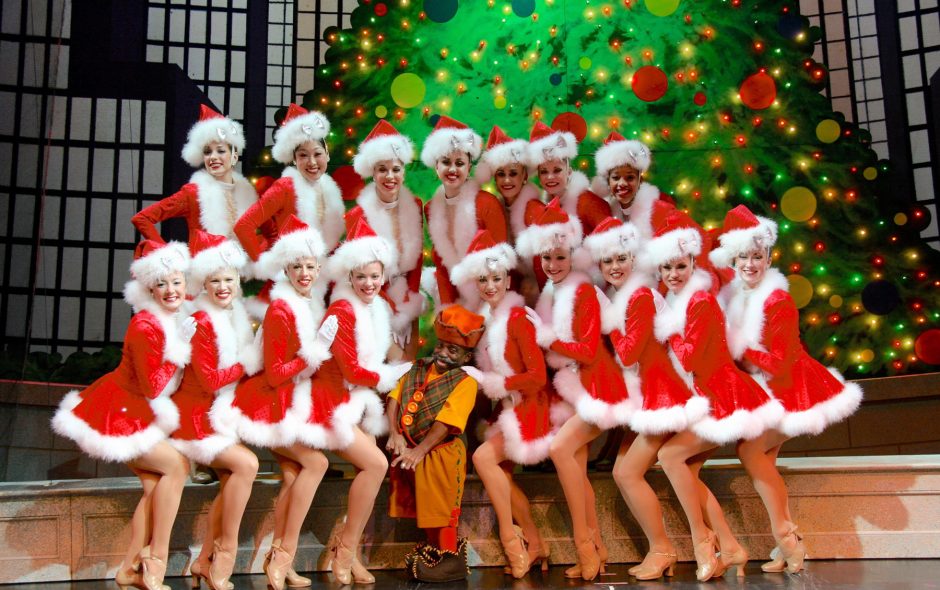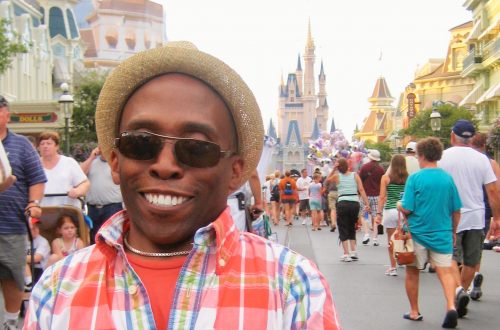Chapter 14: Christmas Is
The days after September 11, 2001, I sat riveted to the images of devastation on my television like the rest of the nation. The thought of flying across the country unnerved me, but when October 17 came, I boarded a plane at LAX with enough clothes to survive autumn in New York and Atlanta, and a December in Cleveland. En route to New York, I stopped in Orlando to drop off my dog, Jack, at my mother’s his a three-month vacation.
A somber feeling came over me as I looked out my airplane window. The televised images of 9/11 became all the more real to me as I noticed the gaping hole in the New York skyline where the World Trade Center towers once stood.
At baggage claim an upbeat young man helped me gather my luggage and drove me to the Upper West Side hotel. Once I got a few things unpacked, I met the other “elves” in the show: Aaron, Trixie, and Kacie. Aaron was in his early thirties, recently married, had the looks of a drama scholar. Trixie resembled a mid-twenties Rosie O’Donnell, only on a smaller scale, with more effervescence sans Rosie’s brassiness. And then there was Kacie. She had to be the most physically like what people would consider an elf: thin, perfectly proportioned, with straight light brown hair that fell to her waist. Despite being in her early twenties, she had the personality of an old soul with a love for all things Hello Kitty. And then there was me, the old man of the group.
The next morning the four of us hopped the subway down to Union Square for our first day of rehearsals. We got to 890 Broadway, presented IDs, took the elevator up, and were greeted by Peter, the executive producer, undoubtedly the nicest man I’d ever met. And over the next few weeks he demonstrated care and concern for each member of the his production.
A piano player, a drummer playing, and a chorus of female voices singing “Kay Thompson’s Jingle Bells” in the main rehearsal room. Our elf quartet walked in and found an out of the way spot on the floor that wasn’t covered with dance bags and backpacks and watched the rehearsal. The room looked like it had been ripped from All That Jazz or any of a dozen other movie musicals with scenes depicting preparations for opening a show. The ceilings were high with exposed pipes. A requisite ballet barre and mirrors lined the back wall. The stage manager and his assistants huddled around a long folding table at one side of the room. Dancing their hearts out in almost three-inch heels in the center of the dance floor were twenty of the most stunning women I’d ever seen in my life, the Radio City Rockettes.
Even in their rehearsal attire, the Rockettes radiated poise and precision. They all wore their hair either up in a bun or pulled away from their faces. Every fiber of their being was caught up in perfecting their choreography. Not only were they dancing in unison, but singing, too. Aloud.
Yeah. I was definitely in the world of Broadway.
Linda, the woman who ran the audition I attended two years prior, scrutinized every signature eye-high kick and inspected every flick of the wrist with a withering gaze. When she clapped her hands to give corrective notes to the dancers, all music and dancing stopped and the Rockettes’ composure fell. Then and only then did they show any sign of exhaustion.
I rehearsed for all sorts of shows at Disney in the past, but the Christmas Spectacular rehearsals made all others look like high school plays. Linda ran a tight ship and commanded the respect of everyone in the room—cast, crew, musicians, spiders spinning webs in the windows—everyone. Only the sound of LaDuca dance shoes on the wooden dance floor, people singing, and musical accompaniment filled the room. Considering forty to fifty people present, only the sound of LaDuca dance shoes on the wooden dance floor, people singing, and musical accompaniment filled the room. Spooky.
At the Magic Kingdom, I worked with other choreographers whose assistants demonstrated the choreography for their dancers. This was not the case with Linda. She wore dance attire and character shoes like everyone else, and when a step wasn’t performed as choreographed, if a simple corrective note wasn’t enough, she stepped onto the dance floor and whipped off the move as well as—if not better than—anyone else on the floor. She had the best dancer’s legs I’d ever seen, and included the women in the Rockette line.
Mark, the same pianist from the same audition I aced a couple years before, greeted us elves at our first rehearsal, a vocal rehearsal. He handed us folders for the Santa’s Workshop scene. I don’t know what I was expecting to see inside the folder, but when I read that Mark wrote the songs we would be singing, I knew the pressure was on. The guy who wrote the song was teaching us the song. Thank God for those years of piano lessons, otherwise my attempts at trying to read the score would have been futile. Mark was encouraging, yet firm in his direction: enunciate and project; at the same time he kept the rehearsal light, but lively.
The actors cast as Santa and Mrs. Claus were delightful. I could tell right away, from the way they carried themselves, that Broadway had been coursing in their veins from way back. A surprisingly thin guy named Scott performed as Santa, but he boomed out a Santa voice that was big, warm, and somewhat paternal.
Bethe, a lithe blond with striking cheekbones and refined facial features, showcased a bubbly personality. Her interpretation of Mrs. Claus was a mash-up of two of America’s funniest comediennes: Lucille Ball and Gracie Allen. Scott and Bethe were charming to watch and the chemistry between them was palpable. The average age of the cast had to be around twenty-five, but having those two in the cast eased my own anxieties about being forty years old, as they were a couple years my senior.
A few weeks after I accepted the Radio City job, I got a package containing my contracts, tentative performance schedule, and cast list. I looked over the cast list and one of the names looked familiar: Stevi. I knew I heard that name before, but couldn’t remember where from. A few days later, it finally dawned on me that one of the dancers at Disney from years ago was named Stevi. She was a kid at the time and proved to be talented even then; and there she was—listed as a Rockette “swing” (an understudy responsible for covering numerous dancers’ roles) and doing eye-high kicks in perfect Rockette form. Later that day we hugged each other and got caught up. And in that moment, I truly felt old.
As time went on, I realized that this show was massive in all respects and I was pretty darned blessed to be a part of it all. Considering they hired me on a phone call and a great score on two-year-old audition, it seemed only fitting to thank whoever was responsible for the opportunity given me.
A couple of days into rehearsals, while walking down one of the halls at 890 Broadway, I ran into Linda. Her walk was purposeful. (Of course, her walk was purposeful. She was the director and choreographer for the show.)
“Hi,” I said in a cheery voice.
“Hello,” Linda said.
“Who should I thank for casting me in the show?”
“That would be me.”
Cue: Clay gushing gratitude (which I did). Linda was mildly amused at my nervousness and continued on her way to whip some more dancers into shape.
After a week and a half of rigorous rehearsals in New York City, we moved on to West Point (yes, the military academy) for a week of technical rehearsals at the Eisenhower Hall Theater. This was officially where my brains seeped out of my ears. Everything I had learned in the rehearsal halls in New York—the choreography, the songs, the blocking—got left behind at the 890 Broadway rehearsal halls. We got on the stage and I felt as if I was starting all over from scratch. I think it was the novelty of seeing the set pieces, the costumes, and the lights that made me come undone.
—
Next we moved on to Atlanta for a few more days of tech rehearsals before we opened. The process of opening a show was basically a layering process. First we learned the onstage stuff: choreography and lyrics, then combined the two. Next, the backstage activities were added: costumes, backstage traffic patterns, and costume quick-changes. Same as with Disney shows, mastering the costume changes and traffic patterns added a new layer of stress, but just like everything else with Radio City the stakes had been taken to a whole new level.
During the tech rehearsal all the elements were put into place. Choreography we rehearsed for weeks was moved to the stage where ginormous set pieces flew in and out. Dozens upon dozens of lighting instruments that were capable of producing any color of the lighting spectrum in the blink of an eye had been hung in the wings and overhead. And the numbers of costumes, wigs, shoes, and accessories were mind-numbing. Last and certainly not least were the thirty plus people in the crew it took to make it all happen.
For me, the biggest challenge wasn’t learning the choreography, but having to sing and dance at the same time. While performing at Disney, I wore a Donald Duck costume, so it didn’t really matter what my face was doing. But during the Santa’s workshop number, my face was out there for all the world to see. And since those clever lyrics were oh-so-similar in verse after verse, that only made getting through the number all the more challenging for me.
Add to that the blocking (the traffic pattern you move on stage during a number), which made perfect sense with the lyrics. The important thing was to land exactly on your spot on the right cue every single time. I finally memorized my choreography, blocking, and lyrics successfully by the time opening night rolled around.
The show opened to rave reviews in Atlanta.
Radio City had some great traditions, one of which was opening night gifts for the cast from the production staff. And in exchange, as a token of appreciation, the cast collected funds to purchase opening night gifts for the production staff. The opening night party was where the cast and crew got to heave a sigh of relief and blow off a lot of steam built up over the previous month and celebrate the show’s opening.
The opening night bash took place at a swanky Atlanta restaurant and everyone noshed to their heart’s content on hors d’oeuvres, beer, wine, fine spirits, and desserts. The majority of folks opted to call it an early night and returned to the hotel for a good night’s sleep before the next day’s shows. The rest of us, the hard core contingent—a mixed bag of straights, gays, females, and males—straggled into one of Atlanta’s after-hours gay bars with a heightened appreciation of one another’s talents, thanks to more than a couple of cocktails.
I made my way into the bar with a handful of people from the show and was shocked to see one of the guys from the crew seated at a table. I remembered his name. It was Frank.
“Hello. Guess which one of Santa’s elves is gay,” I said.
The ice was not broken, but shattered.
Frank laughed and invited me to join him at the bar for a drink. He didn’t have to tell me, I knew he was straight. He was one of those super nice guys who was sensitive and caring. And straight. Frank was also comfortable in his own “straightness” that he was not intimidated in the least by gay men.
“What kind of men do you like?” Frank asked.
“Physically? Or emotionally?” I knew he offered the question as an ice-breaker, not a formal investigation, but I was still a little caught off guard as I couldn’t recall anyone ever asking me that before.
“Both.”
Not having been involved in a relationship for who-knew-how-long gave me more time than I cared to give the matter a lot of thought. I was thrilled that someone, anyone, had an interest in what appealed to me. I recited my wish list with all the enthusiasm of a kid on Santa’s knee.
“I like guys who are smart. If a guy’s not too bright, we’ll have little to talk about. He’s got to have a good sense of humor, life’s too serious to not be able to laugh about things. I like guys who are independent.”
“Independent?”
“Guys who have a life and aren’t all needy and smothering.”
“Yeah, independence is a good thing,” Frank chuckled and nodded.
“And good character is a must. By that I mean it’s not just enough for a guy to know the difference between right and wrong, it’s all about being able to choose right over wrong the majority of the time.”
“Hm,” Frank mulled over my wish list. “Physically?”
“I like beefy guys, but not with a whole lot of marbling. Thin guys, not so much.”
Frank looked a little puzzled, so I simplified things.
“Think firemen.”
I’m sure we talked about other things, none of which I remember, but I do remember that I went to join the rest of the hardcore contingent for a very late night of dancing.
Walking Tall: A Memoir About the Upside of Small and Other Stuff is available at Amazon.com and Apple iTunes.




